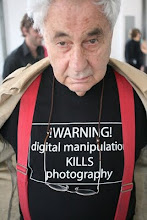BOGLÁRKA ÉVA ZELLEI: FURNISHING THE SACRED
By Aline SmithsonDecember 22, 2018
With Christmas on the horizon, it’s a time to consider Christian rituals or religion in general, especially when shopping for Santa. Boglárka Éva Zellei‘s photographs came to our attention when she garnered 1st Place (along with Mike Whiteley) in our 2018 Seeing is Believing Exhibition, jurored by Drew Nikonowicz. Her series, Furnishing the Sacred, is a fascinating look at religious spaces and the sacred act of baptism. The juxtaposition between this solemn ablution and the quirky containers of purification make for a unique typology.
Boglárka Éva Zellei (1993) is a photographer based in Budapest. She studied Photography at the University of Kaposvár and received her MSc at Moholy-Nagy University of Art and Design, Budapest. She was represented in several exhibitions in Budapest, London, Vienna, Ljubljana and Bratislava. Her works were published in several magazines, for example on the cover of HANT Magazine für Fotografie. In 2018 she was a New East Photo Prize finalist, and earned the Pécsi József Photography Grant. In her works she examines the presence of spirituality and religion in contemporary society and her personal life.
Furnishing the Sacred
In this series I’m dealing with the visual language of contemporary Christian communities through the environments used for immersion baptism. Although this ceremony has been a two-thousand-year old form of christening, every place shows a different religious attitude. The intimacy of the event meets excitingly with the profane needs and possibilities, the tradition with the contemporary taste and unique approaches. How can a sacred event happen in a well designed church and in a inflatable pool with the same spiritual intensity? Everyday objects are arranged in new connections and get new meanings. Their intention to feel at home but also being close to the transcendent world appears in these places. The project is focusing on this human scale and shows the side of religion which is continuously formed and built by humans. I constructed the images in a similar way to emphasize the viewer’s own cultural habits and and reflections. As the environment changes around the figures we can observe how it shapes our visual concepts of religion and the sacred.
Het oude leven afspoelen
Marjoleine de Vos
19 april 2019
Dopen, wassen, baden, reinigen – in allerlei religies hoort iets dergelijks erbij. Veel christenen laten hun kinderen dopen als ze nog piepklein zijn, om ze als het ware meteen ‘in Christus’ te brengen, anderen menen dat iemand eerst moet geloven en dán pas gedoopt kan worden.
Daar kun je flink ruzie over maken.
Ook over het dopen zelf verschillen de meningen: zijn een paar druppels water genoeg of dient de gelovige helemaal onder gedompeld te worden om het oude grondig af te spoelen en als nieuw weer boven te komen?
Ook daar wordt over geruzied.
En altijd met de Bijbel in de hand uiteraard. Marcus 1:5: „Alle inwoners van Judea en Jeruzalem stroomden toe en lieten zich door hem [Johannes de Doper] dopen in de rivier de Jordaan, terwijl ze hun zonden beleden.”
De mensen die hier, op de foto’s van de Hongaarse fotografe Boglárka Éva Zellei in allerhande curieuze badjes gedoopt worden, lijken helemaal geen behoefte te hebben aan zulke disputen. Ze zien er vredig uit. Ze laten zich onderdompelen door een plaatsvervanger van Johannes die zelf ook te water is gegaan, soms plechtig gekleed. Er zijn spatmatjes, doeken, kruizen. Er is veel licht. De houding van de mensen is innig, zorgzaam enerzijds, vol overgave anderzijds. Een enkeling lacht.
Het is allemaal erg lelijk, en erg mooi tegelijk.









































































